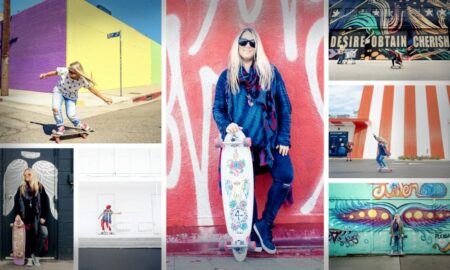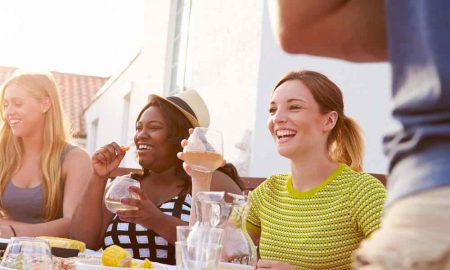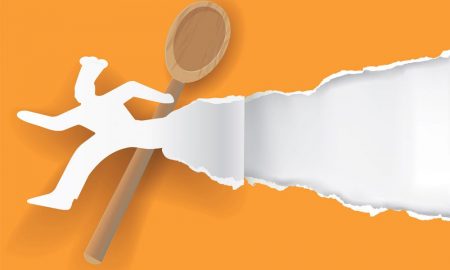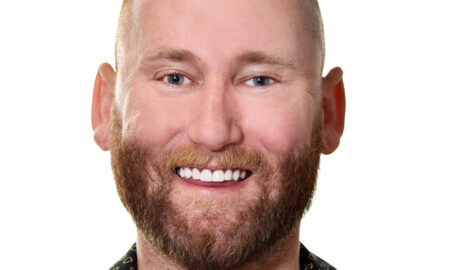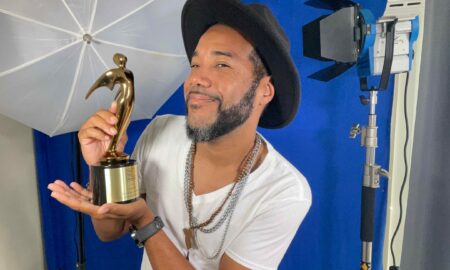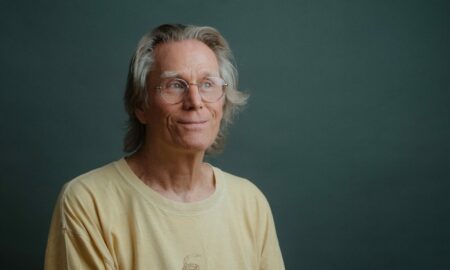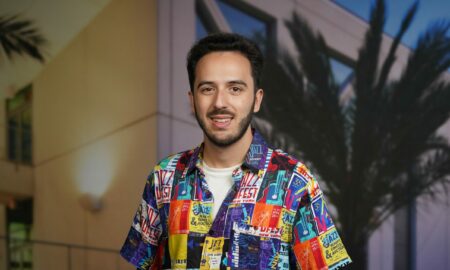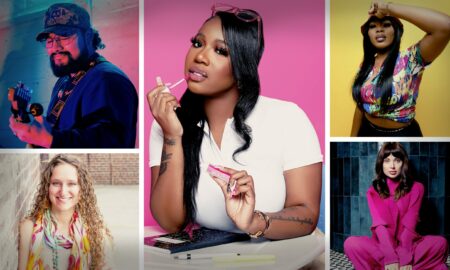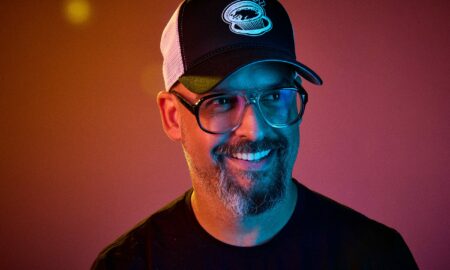

Today we’d like to introduce you to Sean Miller.
Thanks for sharing your story with us Sean. So, let’s start at the beginning and we can move on from there.
Great! Thank you. I guess to begin, I should mention I am an artist, curator, and an associate professor at University of Florida where I teach sculpture. At the moment, I am participating in a Summer residency program at Greywood Art Centre in Killeagh, Ireland. To begin, I should mention that my art blurs boundaries between objects and places, objects and events, and utilizes unconventional art materials. For instance, art museum dust, hurricane water, wood from trees knocked down by hurricanes or removed from museum architecture, termites (as collaborative partners), meteorites, dreams collected from hospital staff and patients, and other items all combine to produce my paintings, sculptures, events, photographs, and installations.
Organizations or groups I have initiated include the co-founding of SOIL collective and gallery (Seattle, Washington 1995-ongoing), The Art Museum Dust Collection (1996-ongoing), John Erickson Museum of Art (JEMA): A Location-Variable Museum (2003-ongoing), co-founding Crude Life Portable Biodiversity Museum for the Gulf of Mexico (2016 with Brandon Ballengee and others), and Drifting Cabinets: A Curious Portable Collection of Gulf Biodiversity (2018). These projects and more may be viewed on my website: seanmillerstudio.net.
In terms of my beginnings as an artist, I started in Seattle, Washington where many of my friends and family live. My early work employed site-specific art, installation art, painting, and photography. I produced collaborative projects, curatorial projects, and solo exhibitions in Seattle. In 1994 Bethany Taylor, myself, and friends co-founded a gallery/art collective called SOIL. It still exists today as an artist-run space. In addition, I was also busy working for the King County Arts Commission and Seattle Art Museum. By working in all these various capacities within the art world I really became fascinated with the way art functions in society, with blending art making with curatorial activities, and with museology. SOIL collective/gallery, the Art Museum Dust Collection, and my JEMA museum were playful yet critical responses and grew out of those early experiences. In 1996 Bethany and I got married and in 1999 we moved to Gainesville for visiting faculty positions at University of Florida’s School of Art and Art History and we had a daughter, earned tenure, and made Gainesville our home.
At the same time, I was hired at University of Florida, I was invited to participate in “Horsehead” an international outdoor sculpture exhibition curated by Matthew Lennon that occurred both in Seattle, Washington, and Belfast, Northern Ireland. In Belfast, the sculptural works occurred throughout the entire city and were designed to be temporary and site-specific. This exhibition introduced me to other artists, collaborators, and curators abroad. Obviously, the energy, collaboration, and momentum of SOIL and later JEMA also helped me branch out and work with many new people and exhibit in new contexts within the U.S. and abroad.
Has it been a smooth road?
The road is smoothest for me when I develop new project(s), exhibitions, and courses that ask interesting questions that make me work hard to discover new ideas, processes, meet new people, and explore new approaches. My road has a lot of lanes in it and covers a lot of ground I think. I usually work with several different collaborators in producing artworks. Recently I worked with Brandon Ballengee on the two-year project Crude Life. Another longtime collaborator is designer Connie Hwang who has worked on several different projects such as the Art Museum Dust Collection and Dream Registry (that also includes artist Jess Larson). I also work with a lot of scientists and ecologists to create my projects. I am lucky to teach with talented artists, like Bethany Taylor (WARP course) and also Coco Fusco and Sergio Vega are colleagues along with Lab Technician Brad Smith in the UF Sculpture Program. I also am in regular contact with curators I admire like Jade Dellinger at Bob Rauschenberg Gallery (Fort Myers) and Caterina Gualco at Unimediamodern Gallery (Genoa, Italy) who consistently produce exhibitions that amaze me.
I am lucky to teach an exciting array of students at UF at all levels within the School of Art and Art History so I work with 1st-year students through graduate students. I am always trying to arrange interesting experiences and opportunities for them as well. Then, of course, there is also my family life that rewards me and teaches me so much. So, my road is smooth when all these lanes are busy and flowing with new productive and interesting events and ideas. You know, sometimes on the road, there are jams, accidents, even pile-ups but I do my best to learn from those and not lose all the forward momentum. Onward! By the way, these are bike lanes in my analogy, not a freeway. I’m trying to reduce the carbon footprint in my metaphorical references.
We’d love to hear more about your work and what you are currently focused on. What else should we know?
Currently, here in Ireland, I am teaming up with an Irish art group called Softday on “The Hodges Effect (An Investigation Into the Mysterious Agency of Space Grit & Tiny Scraps Of Metal).” The Hodges Effect is a condition we define as the sudden collision between a human subject and extraterrestrial materials resulting in physical changes and/or an existential crisis of being. The namesake for the “Hodges Effect” originates from the Ann Hodges Alabama meteor-strike incident of 1954. Hodges was hit by a softball-sized meteor while napping in her bed at home. It’s an incredible story. The meteor came from the direction of the sun, punctured her roof, bounced off her radio, struck her in the side (waking her up confused, frightened, and with a terrible bruise), and she lived!
It is theorized that the Hodges Effect may result from space travel, space research, or through direct interaction with or experiencing cosmic events or materials. Although the effect is known to contribute to angst, mental disorientation, and nausea, the long-term effects on the human subject is currently unknown. Surprisingly in many cases the after-effects of Hodges seem to imbue individuals with a greater spatial awareness, an increased sense of interconnectedness with the cosmos, and a more complex and informed understanding of the material world. Our team believes that further research into Flann O’Brien’s “molecule theory”, the Ann Hodges case, the Overview Effect (experienced by astronauts), and research into object-oriented ontology may provide a basic foundation for better understanding the Hodges Effect phenomenon. We also believe Jazz great Sun Ra may have been benefited from his own Hodges Effect experiences.
My new project with Softday seeks to provide an efficient creative aesthetic framework to actually induce the Hodges Effect for our exhibition visitors with the intention of bringing about the positive after-effects and minimizing stress on the audience. We are currently planning sound compositions, special tools and instruments, extraterrestrial sculptures, and opportunities for actual physical contact with (and the organized collection of) micrometeorites to bring about the acute (but positive) Hodges Effect responses as a service to the public. We are in the early stages of collecting meteorites and developing our equipment but I will be back in Ireland in March 2020 for a stay at Sirius Art Centre to begin the next phase of the project.
Throughout the Spring, I have been focused on making work and touring Drifting Cabinets: A Curious Portable Collection of Gulf Biodiversity. This portable art/science collection dedicated to presenting biodiversity and ecological issues in the Gulf of Mexico. Collection holdings include biological specimens, art, illustrations, videos, scientific instruments, books, artifacts, and music—offering viewers a multifaceted portrait of life in the Gulf region. This mobile collection functions as a contemporary cabinet of wonder, exhibited in a series of vintage steamer trunks, each addressing an aspect of regional biodiversity—featuring invertebrates, reptiles, and others. Trunks are refurbished with custom lighting and retrofitted with inlaid wood recycled from regional architecture and trees lost in Hurricane Irma. The watercolor illustrations I do for the collection are made with water I collected from Hurricane Irma.
The entire collection embodies, presents, and is constructed with the materials from the Gulf region. Numerous scientists and artists from the Gulf of Mexico contribute to the project. The project has toured throughout Florida and Georgia in art and science museums, universities, and even breweries. It is designed to open anywhere to reach large audiences. Drifting Cabinets was a follow-up to the project Crude Life that I collaborated on with Brandon Ballengee in Louisiana. Brandon is an artist and scientist, and he contacted me in 2015 and invited me to see his amazing exhibition Frameworks of Absence for the Armory Show and mentioned that he had seen and enjoyed my project the John Erickson Museum of Art (JEMA): A Location-Variable Museum. I showed him my bike art piece “Mobile Wunderkammer” (2015) and he was kind to offer writing for the book/catalogue “Repurposing the Wunderkammer” for an exhibition of the same name at the Samuel P. Harn Museum of Art. This led to our work together on Crude Life, whereby I collaborated by inviting artists and scientists to collaborate, collecting specimens, producing displays, illustrations, photographic art, and designing the identity and interiors of the steamer trunks. It was exciting because we creating and introducing a new mobile museum for the Gulf of Mexico from the ground up.
Something that I always seem to return to in my projects is a fascination with designing artworks that function portably and autonomously – in other words works that side-step the gallery or museum and go directly into the public realm. As previously mentioned, prior to Crude Life and Drifting Cabinets I worked on JEMA (the John Erickson Museum of Art). The museum’s namesake is in homage to my great-grandfather. John Erickson worked for 35 years in the Arcade Building in Seattle, Washington and died in 1945. Erickson operated a little watchmaking, engraving, and jewelry store in the (now demolished) section of the Arcade Building where Robert Venturi’s Seattle Art Museum (SAM) currently occupies. Erickson’s store was on the third floor and looked out over 2nd Avenue. JEMA is a small replica of the SAM gallery (minus the art) that occupies that space. The JEMA gallery fits into an aluminum carry case that in turn fits into the overhead bins on airplanes. So, every exhibition at JEMA is a traveling exhibition. Exhibition opening festivities are also proportionately scaled down so every opening only lasts two minutes.
This project utilizes miniature galleries and architectural spaces as well as sculpture, photography, performance, publicity, and web-based work, to create the semblance of a functioning contemporary art museum (or arguably the genuine artifact). By adopting a persona and positioning myself as the founder and director of JEMA, I am able to guide the project into different public contexts and meaningfully nuanced public exhibition scenarios. Since 2003 a number of notable contemporary artists have exhibited at JEMA and the museum has had invited and guerilla exhibitions at museums, art centers, art fairs, and galleries throughout the U.S., U.K., Ireland, Italy, Finland, Germany, and Spain.
Is there a quality or characteristic that has played an outsized role in your success?
I suppose it is that my art projects are generally designed to be ongoing, collaborative, and generative. By “generative,” I mean that it is intentionally designed to include other creative individuals to make contributions that inform the piece – work that generates ongoing investigations and creative activity. I set up a structure or premise that becomes a somewhat open forum. I then begin work, curating/inviting others to enter into the project. I see all this as similar to inventing a board game or playground and inviting a bunch of really fun people to come over and play. And I don’t mean to trivialize the outcomes from this approach. I truly believe a lot of meaningful things come out of playful strategies. Just because we are putting things into a state of play doesn’t mean we are not serious about the things we are questioning. For instance, to foster collaboration, communication, and engage diverse audiences, I find value in employing invented fictitious institutional identities, corporate branding, site-specific interventions, photography, scale models, advertising, performance art, and performative objects as modes of artistic expression. All this is intended to raises awareness, activate imaginations, and allow for a lot of different ways to access the collaborative projects I am producing or presenting.
As a result of these projects, I am pleased with the opportunity to work with so many creative minds and talents. Through JEMA, Crude Life, and Drifting Cabinets I have collaborated with the Art Guys, Yoko Ono, Oliver Herring, Connie Hwang, Chip Lord (Ant Farm Co-Founder), Kristin Lucas, Tea Mäkipää, Arnold Mesches, Ben Patterson (Fluxus Pioneer), Bethany Taylor, Sergio Vega, and many others.
Thanks for the interview. In closing, watch out for little museums moving about in the streets, think carefully about the natural world and the Gulf region, and watch closely for falling stars and space dust.
Contact Info:
- Website: http://www.seanmillerstudio.net/, http://dreamregistry.net/
- Dream Registry: http://dreamregistry.net/
- Email: swarp@ufl.edu
- Facebook: https://www.facebook.com/JohnEricksonMuseumofArt/
- Other: John Erickson Museum of Art Website http://www.jema.us/
More information and links to Sean Miller’s work:
Chip Lord and Sean Miller interviewed about Drifting Cabinets (2019)
https://news.wgcu.org/post/drifting-cabinets-pop-exhibition-comes-bob-rauschenberg-gallery
Art Museum Dust Collection CBS News
https://www.cbsnews.com/pictures/photos-of-museums-tiniest-features/
Repurposing Wunderkammer Review
https://burnaway.org/review/wunderkammers-21st-century-harn-gainesville/
JEMA Retrospective Exhibition at Bob Rauschenberg Gallery
http://artdistricts.com/jema-10-years-retrospective/






 Image Credit:
Image Credit:
Mobile Wunderkammer: Insectarium, Sean Miller. Drifting Cabinets Invertebrate Trunk and Fish Trunk Exhibit Detail. Photo Sean Miller. Drifting Cabinets at Florida Museum of Natural History. Photo by Kristen Grace. Crude Life at National Academy of Sciences, Beckman Center, Irvine, California. Wallpaper by Mark Dion (previous installation). Sean Miller in collaboration with Brandon Ballengee. Rachel Mayeri’s video “Crude Life Critters Speak Seven Years After the BP Oil Spill” at far end of room. Photo by NAFKI’s Paul Kennedy. John Erickson Museum of Art in Dietch Projects Art Parade, NYC. Photo by David Rainey. Yoko Ono, Imagine Peace, John Erickson Museum of Art location-variable exhibition at Peace Walls in Belfast, Northern Ireland. Also on view at Golden Thread Gallery and Flax Arts Residency Program. Photo by Sean Miller. Gregory Green, Sean Miller, and other citizens of the Free State of Caroline. Sean Miller a citizen of Caroline carries the mobile consulate for the nation (a nation founded by Green). Image still for “How to Start Your Own Country.” A documentary film by Jody Shapiro. Photo by Jody Shapiro and Gregory Green. “Eleven” JEMA Retrospective at Bob Rauschenberg Gallery and Samuel P. Harn Museum of Art. Photo by Sean Miller. Art Museum Dust Collection, Microscopy of Dust Sample Collected from the Musee Du Louvre, Paris, France. Photo by Sean Miller.
Getting in touch: VoyageMIA is built on recommendations from the community; it’s how we uncover hidden gems, so if you know someone who deserves recognition please let us know here.


